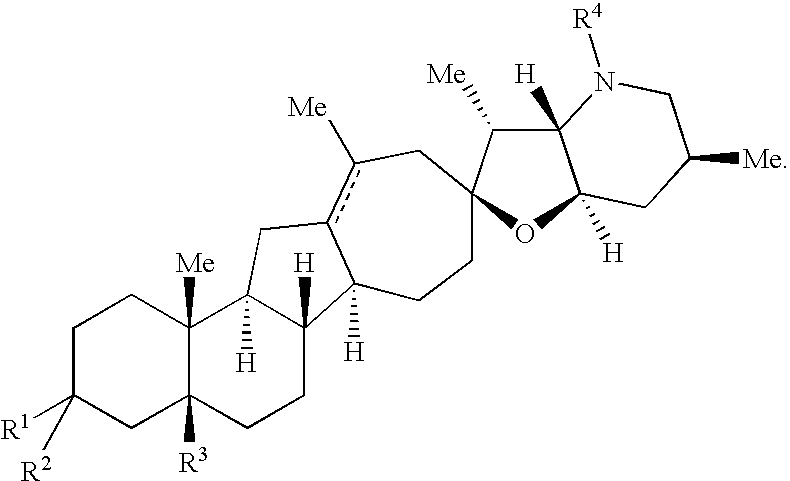Cyclopamine analogs
a technology of cyclopamine and analogs, applied in the field of cyclopamine analogs and pharmaceutical compositions, can solve problems such as cell death in a number of cancer types
- Summary
- Abstract
- Description
- Claims
- Application Information
AI Technical Summary
Benefits of technology
Problems solved by technology
Method used
Image
Examples
example 1
Step A
Recrystallized cyclopamine 2 (14.1 g, 34.0 mmol, 1 eq) is dissolved in anhydrous DCM (70 mL) and anhydrous MeOH (29 mL). The clear solution is cooled, and triethylamine (10.4 g, 102.7 mmol, 3 eq) followed by benzyl chloroformate (6.20 g, 36.3 mmol, 1.1 eq) is added. After the addition is complete, the solution is stirred in the ice bath for 30 min. Three portions of benzyl chloroformate (3×0.35 g, 3.46 mmol, 0.03 eq) are added over the 3 h. The reaction is slowly quenched with water (71 mL), while maintaining the temperature below 20° C. The mixture is stirred for 15 min before the layers are settled and separated. The organic layer is dried over sodium sulfate and filtered. The combined filtrate is buffered with anhydrous pyridine (30 mL), concentrated, and solvent exchanged with additional anhydrous pyridine (43 mL) and concentrated.
The solution of the compound in pyridine (43 mL) is further diluted with additional anhydrous pyridine (85 mL). Trimethylacetyl chloride (8.3 g,...
example 2
Step A
Cyclopamine 2 (5.02 g, 12.2 mmol, 1.0 eq) is dissolved in anhydrous pyridine (25 mL). DMAP (300 mg, 2.44 mmol, 0.2 eq.) and triethyl amine (5.5 mL, 39.1 mmol, 3.2 eq) are added, followed by BtO-Cbz (10.5 g, 39.1 mmol, 3.2 eq) and heated at 40° C. for 2 h. The mixture is cooled to rt, treated with 30 mL water, heated to get a homogeneous solution and allowed to cool to room temp. The white precipitate that formed is collected by filtration, the filter cake is washed with portions of water (3×50 mL), and dried in air to afford 9.53 g of crude material which is crystallized from toluene / heptanes (1:9, 70 mL) to give 6.75 g of the desired product.
Step B
To a solution of diethyl zinc (572 mg, 482 μL, 4.63 mmol, 3.00 eq) in 5.0 mL DCM at −20° C. is added a solution of bis-(2,6-Dimethylphenyl)phosphoric acid (1.42 g, 4.63 mmol, 3.00 eq) in DCM (15 mL) maintaining the reaction temperature below −8° C. The solution is aged for 15 min. at 0° C., neat diiodomethane (1.24 g, 374 μL, 3.00 e...
example 3
In a seal tube, ketone 6 (85 mg, 0.199 mmol, 1 equiv.) was charged and triethyleneglycol (2 mL) was added followed by hydrazine monohydrate (500 mg, 10 mmol, 50 equiv.) and potassium carbonate (138 mg, 1 mmol, 5 equiv.). The tube was sealed and the reaction was heated at 150° C. for 16 h. The reaction was cooled to rt and water was added. The residue was extracted with chloroform (3×). The combined organic layers are washed with water, dried over Na2SO4, and concentrated to dryness. The colorless oil was purified using silica gel flash chromatography (DCM / MeOH 96:4). The purified fractions are pooled and concentrated to dryness. The resulting oil was dissolved in MTBE and washed with water (2×), 2N NaOH, and then brine. The combined organic layers are dried over Na2SO4, filtered and evaporated to afford 64 mg of the desired material as a white foam. ([M+H]=412.7 m / z).
PUM
 Login to View More
Login to View More Abstract
Description
Claims
Application Information
 Login to View More
Login to View More - R&D
- Intellectual Property
- Life Sciences
- Materials
- Tech Scout
- Unparalleled Data Quality
- Higher Quality Content
- 60% Fewer Hallucinations
Browse by: Latest US Patents, China's latest patents, Technical Efficacy Thesaurus, Application Domain, Technology Topic, Popular Technical Reports.
© 2025 PatSnap. All rights reserved.Legal|Privacy policy|Modern Slavery Act Transparency Statement|Sitemap|About US| Contact US: help@patsnap.com



